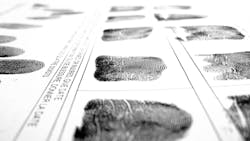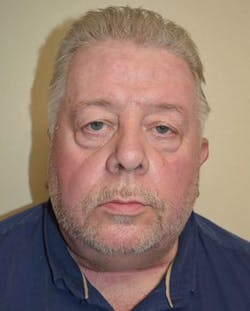May 20, 1987: 79-year-old Grace Hayden is found dead in her San Diego home. She was partially nude and covered by a blanket. As an aging woman, Grace’s health was in decline. She was partially blind and had difficulty getting around on her own. She relied on caregivers to assist her, and it was one of her caregivers who discovered her body and contacted police. Grace often left her front door unlocked so her caregivers could come in, as it would be troublesome for her to get up and let them in. This raised a question: did a random scumbag darken her doorstep and hit the jackpot when they found an unlocked door, or did someone who knew her and her habits come around with ill intentions?
The autopsy found Grace had been raped before being smothered by the blanket. So much force was applied by the attacker, she suffered facial injuries and her dentures were dislodged, blocking her airway. Grace’s purse had also been rummaged through and some prescription painkillers were stolen. DNA was located on Grace’s body. At the time of the murder, DNA testing was not advanced enough to adequately test the DNA swabs, however they were submitted to the FBI for comparison in 2003. No match was returned, unfortunately. Homicide detectives processed the scene and located a single fingerprint on the stove in the kitchen. Two of the burners had been turned on, but it remains unclear why the killer did this. The fingerprint was also submitted for comparison in a local database, but did not match any suspects. The murder of Grace Hayden would remain unsolved, and the killer would remain free, until a deputy on the other side of the country decided to take an extra step while booking an arrestee, 28 years later.
For the uninitiated, fingerprints are the residual impressions of a persons fingers, left behind after contact with an object. The unique pattern of the ridges on someone’s fingers are transferred by the oils of the skin, or other materials such as blood, dust, grease, etc. Fingerprints, which can’t be seen without the aid of powders or chemicals are referred to as latent prints. Latent prints will be lifted, typically using tape, and pressed onto a card to preserve the print. Exemplar prints are the fingerprint impressions deliberately taken from a person for the purpose of comparison. Exemplar prints are most often transferred onto paper after applying ink to the fingers, or using a digital scanner, and are typically taken during the standard booking process of an arrestee. When investigators find latent fingerprints at a scene, they will be submitted to a local, state or federal database to be compared with exemplar prints taken from known criminals. The databases will identify any possible matches, which then have to be painstakingly compared by a fingerprint expert. Every minute detail of every single finger must be analyzed and given a score, based on points of identification. The higher the score, the higher the probability of a match, thus identifying a suspect. In short, it is not as easy as it looks on television.
Kevin Thomas Ford, who was born in North Carolina in the mid-1950s, was a troubled man. At the age of 16, Ford dropped out of high school in order to care for his ailing mother. He later served for three years in the United States Army. He found himself in San Diego in the mid-1980s as he reached his 30s. Ford developed a cocaine addiction, which led to a divorce and made it difficult for him to hold a job for a long period. After being fired from the U.S. Postal Service, he would become a driver for a medical transport service. One of Ford’s clients was Grace Hayden. He drove her to and from doctor’s appointments on multiple occasions. Desperate for money to pay his dealer and a drug-fueled need for sex, Ford decided to pick an easy target. Knowing Grace Hayden’s door was most likely unlocked and she was almost certainly alone, he got high on cocaine and entered the home. After the rape and murder, Ford searched for valuables, turned on the stove, perhaps in hope of causing a fire which would destroy any evidence of the attack, and fled the home. Regardless of what Ford made as a driver and what he took from Grace’s apartment, it was apparently not enough to make ends meet for him and his drug habit, as he eventually found himself living in his company van. Naturally, the transport service didn’t take kindly to this and terminated Ford’s employment. Sometime afterwards, Ford moved back to North Carolina where he would marry his second wife and settle into a new life in St. Pauls.
Aside from minor traffic violations, Ford was able to avoid any more serious trouble up until 2015. He apparently had a dispute with the staff of a private medical practice about his prescriptions. During the altercation, Ford allegedly made threatening statements towards the staff members; a misdemeanor offense in North Carolina. Robeson County Sheriff’s Deputy James Blount responded to handle the complaint. He later contacted Ford over the phone and convinced him to turn himself in at the sheriff’s office on the misdemeanor warrant. During this time it was not standard practice to fingerprint arrestees for misdemeanor warrants, however, Deputy Blount decided to take Ford’s prints, just in case. The charge against Ford was eventually dismissed, but his fingerprints were now in the FBI’s national database.
In 2018, Tony Johnson, an investigator for the San Diego District Attorney’s Office, was looking into cold cases when he came across the unsolved murder of Grace Hayden. While examining the evidence he realized the fingerprint from the stove had never been entered into the national database. If it hadn’t been for the thoroughness of Deputy Blount, this would have been a fruitless endeavor, but after 31 years, Ford became the prime suspect. A search warrant for his DNA was issued and he was soon apprehended in North Carolina where a DNA sample was taken, as well as additional finger and palm prints. The DNA found on Grace Hayden’s body was positively matched to Ford, and the additional prints sealed his fate. An arrest warrant was issued for Ford and he was extradited back to San Diego to stand trial. Ford was eventually found guilty after denying the allegations, insisting the rape was actually consensual sex and he had nothing to do with her death. Ford was sentenced to life in prison after Hayden’s only known relative chose to forgive Ford, rather than push for the death penalty.
Ford wrote a letter to his wife, stating he knew he may be arrested for the murder some day, but he did not know how good the evidence would be. Sadly for him, fingerprints don’t lie, and it is more than a little ironic that Ford himself was the one who provided that evidence to begin with.




